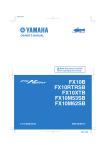Download HP Visualize J7000 Programming instructions
Transcript
fx Graphics Card Installation and Configuration Guide HP VISUALIZE fxe, fx5 and fx10 Graphics Family HP Part No. A1299-90002 Edition: E0601 Legal Notices The information in this document is subject to change without notice. Hewlett-Packard makes no warranty of any kind with regard to this manual, including, but not limited to, the implied warranties of merchantability and fitness for a particular purpose. Hewlett-Packard shall not be held liable for errors contained herein or direct, indirect, special, incidental or consequential damages in connection with the furnishing, performance, or use of this material. HP Product HP Visualize fx Graphics cards Duration of Warranty 1 year HEWLETT-PACKARD WARRANTY STATEMENT 1. HP warrants HP hardware, accessories and supplies against defects in materials and workmanship for the period specified above. If HP receives notice of such defects during the warranty period, HP will, at its option, either repair or replace products that prove to be defective. Replacement products may be either new or like new. 2. HP warrants that HP software will not fail to execute its programming instructions, for the period specified above, due to defects in material and workmanship when properly installed and used. If HP receives notice of such defects during the warranty period, HP will replace software media which does not execute its programming instructions due to such defects. 3. HP does not warrant that the operation of HP products will be uninterrupted or error free. If HP is unable, within a reasonable time, to repair or replace any product to a condition as warranted, customer will be entitled to a refund of the purchase price upon prompt return of the product. 4. HP products may contain remanufactured parts equivalent to new in performance or may have been subject to incidental use. 5. The warranty period begins on the date of delivery or on the date of installation if installed by HP. If customer schedules or delays HP installation more than 30 days after delivery, warranty begins on the 31st day from delivery. 6. Warranty does not apply to defects resulting from (a) improper or inadequate maintenance or calibration, (b) software, interfacing, parts or supplies not supplied by HP, (c) unauthorized modification or misuse, (d) operation outside of the published environmental specifications for the product, or (e) improper site preparation or maintenance. 7. TO THE EXTENT ALLOWED BY LOCAL LAW, THE ABOVE WARRANTIES ARE EXCLUSIVE AND NO OTHER WARRANTY OR CONDITION, WHETHER WRITTEN OR ORAL, IS EXPRESSED OR IMPLIED AND HP SPECIFICALLY DISCLAIMS ANY IMPLIED WARRANTIES OR CONDITIONS OF MERCHANTABILITY, SATISFACTORY QUALITY, AND FITNESS FOR A PARTICULAR PURPOSE. 8. HP will be liable for damage to tangible property per incident up to the greater of $300,000 or the actual amount paid for the product that is the subject of the claim, and for damages for bodily injury or death, to the extent that all such damages are determined by a court of competent jurisdiction to have been directly caused by a defective HP product. 9. TO THE EXTENT ALLOWED BY LOCAL LAW, THE REMEDIES IN THIS WARRANTY STATEMENT ARE CUSTOMER'S SOLE AND EXCLUSIVE REMEDIES. EXCEPT AS INDICATED ABOVE, IN NO EVENT WILL HP OR ITS SUPPLIERS BE LIABLE FOR LOSS OF DATA OR FOR DIRECT, SPECIAL, INCIDENTAL, CONSEQUENTIAL (INCLUDING LOST PROFIT OR DATA), OR OTHER DAMAGE, WHETHER BASED IN CONTRACT, TORT, OR OTHERWISE. FOR CONSUMER TRANSACTIONS IN AUSTRALIA AND NEW ZEALAND: THE WARRANTY TERMS CONTAINED IN THIS STATEMENT, EXCEPT TO THE EXTENT LAWFULLY PERMITTED, DO NOT EXCLUDE, RESTRICT OR MODIFY AND ARE IN ADDITION TO THE MANDATORY STATUTORY RIGHTS APPLICABLE TO THE SALE OF THIS PRODUCT TO YOU. Warranty. A copy of the specific warranty terms applicable to your Hewlett-Packard product and replacement parts can be obtained from your local Sales and Service Office. Restricted Rights legends. Use, duplication or disclosure by the U.S. Government is subject to restrictions as set forth in subparagraph (c) (1) (ii) of the Rights in Technical Data and Computer Software clause at DFARS 252.227-7013 for DOD agencies, and subparagraphs (c) (1) and (c) (2) of the Commercial Computer Software Restricted Rights clause at FAR 52.227-19 for other agencies. HEWLETT-PACKARD COMPANY 3404 E. Harmony Rd. Fort Collins, CO U.S.A. Copyright Notices. ©copyright 1983-2000 Hewlett-Packard Company, all rights reserved. Reproduction, adaptation, or translation of this document without prior written permission is prohibited, except as allowed under the copyright laws. ©copyright 1979, 1980, 1983, 1985-93 Regents of the University of California ©copyright 1980, 1984, 1986 Novell, Inc. ©copyright 1986-1992 Sun Microsystems, Inc. ©copyright 1985-86, 1988 Massachusetts Institute of Technology. ©copyright 1989-93 The Open Software Foundation, Inc. ©copyright 1986 Digital Equipment Corporation. ©copyright 1990 Motorola, Inc. ©copyright 1990, 1991, 1992 Cornell University ©copyright 1989-1991 The University of Maryland ©copyright 1988 Carnegie Mellon University Trademark Notices: UNIX is a registered trademark in the United States and other countries, licensed exclusively through X/Open Company Limited. X Window System is a trademark of the Massachusetts Institute of Technology. MS-DOS and Microsoft are U.S. registered trademarks of Microsoft Corporation. OSF/Motif is a trademark of the Open Software Foundation, Inc. in the U.S. and other countries. 4 Contents 1. Introduction Related Documents . . . . . . . . . . . . . . . . . . . . . . . . . . . . . . . . . . . . . . . . . . .9 Prerequisites . . . . . . . . . . . . . . . . . . . . . . . . . . . . . . . . . . . . . . . . . . . . . . .11 Making Software and Device-Specific Changes . . . . . . . . . . . . . . . . . . . .14 System Configuration. . . . . . . . . . . . . . . . . . . . . . . . . . . . . . . . . . . . . . .14 Special Considerations . . . . . . . . . . . . . . . . . . . . . . . . . . . . . . . . . . . . . .14 Higher Resolution 3D on fxe (rev-B) Card . . . . . . . . . . . . . . . . . . . . . .15 Checklist For Making Software Changes . . . . . . . . . . . . . . . . . . . . . . . . .16 General Hardware Installation Instructions . . . . . . . . . . . . . . . . . . . . . .18 Supported Graphics Slot Configurations . . . . . . . . . . . . . . . . . . . . . . . . .20 B1000 and C3x00 Graphics Slots . . . . . . . . . . . . . . . . . . . . . . . . . . . . .20 B2000 Graphics Slots . . . . . . . . . . . . . . . . . . . . . . . . . . . . . . . . . . . . . . .21 J6x00 Graphics Slots . . . . . . . . . . . . . . . . . . . . . . . . . . . . . . . . . . . . . . .21 J5x00 and J7000 Graphics Slots . . . . . . . . . . . . . . . . . . . . . . . . . . . . . .22 Fixing Common Installation Problems. . . . . . . . . . . . . . . . . . . . . . . . . . .23 Monitor Does Not Display . . . . . . . . . . . . . . . . . . . . . . . . . . . . . . . . . . .23 System’s X-server or CDE Does Not Come Up or Recognize the Graphics Card24 A. Monitor Timing 1280 x1924 75 Hz VESA . . . . . . . . . . . . . . . . . . . . . . . . . . . . . . . . . . . . . .26 1024 x768 75 Hz VESA . . . . . . . . . . . . . . . . . . . . . . . . . . . . . . . . . . . . . . .27 1280 x1024 60 Hz Digital Flat Panel . . . . . . . . . . . . . . . . . . . . . . . . . . . .28 1600 x1200 75 Hz VESA . . . . . . . . . . . . . . . . . . . . . . . . . . . . . . . . . . . . . .29 1600 x 1024 76 Hz . . . . . . . . . . . . . . . . . . . . . . . . . . . . . . . . . . . . . . . . . . .30 1920 X 1200 60 Hz . . . . . . . . . . . . . . . . . . . . . . . . . . . . . . . . . . . . . . . . . . .31 1920 x 1080 68 Hz . . . . . . . . . . . . . . . . . . . . . . . . . . . . . . . . . . . . . . . . . . .32 5 Contents 1280 x 1024 100 Hz Stereo in a Window. . . . . . . . . . . . . . . . . . . . . . . . . 33 1024 x 768 120 Hz Stereo in a Window. . . . . . . . . . . . . . . . . . . . . . . . . . 34 1280 x 1024 85 Hz VESA . . . . . . . . . . . . . . . . . . . . . . . . . . . . . . . . . . . . . 35 1280 x 1024 75 Hz VESA . . . . . . . . . . . . . . . . . . . . . . . . . . . . . . . . . . . . . 36 1024 x 768 85 Hz VESA . . . . . . . . . . . . . . . . . . . . . . . . . . . . . . . . . . . . . . 37 1024 x 768 85 Hz VESA . . . . . . . . . . . . . . . . . . . . . . . . . . . . . . . . . . . . . . 38 B. Regulatory Information FCC . . . . . . . . . . . . . . . . . . . . . . . . . . . . . . . . . . . . . . . . . . . . . . . . . . . . . . 40 VCCI . . . . . . . . . . . . . . . . . . . . . . . . . . . . . . . . . . . . . . . . . . . . . . . . . . . . . 41 Declaration of Conformity . . . . . . . . . . . . . . . . . . . . . . . . . . . . . . . . . . . . 42 6 1 Introduction This manual covers the installation and configuration of the HP Visualize fx family of graphics cards (fxe, fx5, fx10a and fx10b) into HP Workstations released after September1999. These workstations include the B1000, B2x00, C3x00, J5x00, J6x00 and J7000. Chapter 1 7 Introduction The HP A4982A Visualize fxe card is an entry level, 2D/3D graphics card with 18 Mbytes of SGRAM. It provides analog video only through a standard 15-pin miniature D-sub connector. The A4982B version of the HP Visualize fxe card (above) has 24 Mbytes of SDRAM and features an available texture memory at 1280 x 1024 resolution of 9.5 Mbytes instead of the 3.5 MBytes for the A4982A. The two cards are fully pixel compatible. Applications qualified to run on the rev-A card will run without difference on the rev-b card. The extra memory provided by the A4982B card allows 1600x1200 and 1600x1024 resolutions previously only supported on 2D. Due to the change in memory type (from SGRAM to SDRAM) some applications may see some interactive windowing operations (for example moving opaque windows) run slightly slower. A new revision of the X server will minimize these problems. For HP-UX 10.20 users, get patch PHSS_23535 or its replacement; for HP-UX 11.x users, get PHSS_23546 or its replacement. To take advantage of the increased resolution provided by the rev-b card, see page 15 for instructions. NOTE To determine which fxe card is in your Workstation, check the following file: /opt/graphics/common/bin/graphinfo - under CONFIGURATION INFORMATION, the line ‘Total framebuffer memory’ will show 24 Mbytes for the rev-b card and 18 Mbtyes for the rev-a card. If you execute /opt/graphics/common/bin/setmon -rv, the newer card will show the HPA4982B product number. The HP Visualize fx5 2D/3D graphics accelerator card is a mid-level graphics card. The fx5 Pro features 64MB of SDRAM, a single geometry accelerator ASIC and a single ASIC for rastering and texturing. The HP Visualize fx10a 2D/3D graphics accelerator card is an high-end graphics card. The fx10a Pro features dual geometry accelerator ASIC's, and a single rastering and texturing ASIC The HP Visualize fx10b 2D/3D graphics accelerator card is also an high-end graphics card. The fx10b Pro features 128 Mbytes of DDR RAM, dual geometry accelerator ASIC's, and a single rastering and texturing ASIC. It replaces the fx10a as of November 2000. 8 Chapter 1 Introduction Related Documents All fx family graphics cards require a PCI 2X interface to the HP-UX workstation backplane. This manual also describes the basic prerequisites for installing HP Visualize fx graphics cards into the supported workstations. The table below lists the various graphics products covered by this manual, and their respective product numbers. Table 1-1 Supported Graphics Products Product Number Product Description A4982A HP Visualize fxe A4982B HP Visualize fxe (rev-b) A1262A HP Visualize fx5 A1299A HP Visualize fx10a A1299B HP Visualize fx10b Related Documents See the following documents for more information on graphics and on your particular workstation. • the Owner's Guide for your workstation • Common Desktop Environment User's Guide • HP Visual User Environment User's Guide • Using HP-UX • Using the X Window System • Graphics Administration Guide found on the http://www.hp.com/workstations/support web site • http://www.hp.com/workstations is the general website for workstation information • http://www.software.hp.com is the software depot website for HP-UX Chapter 1 9 Introduction Related Documents • http://www.docs.hp.com is the website for documents regarding HP-UX systems • http://www.hp.com/workstations/support is the website for software and firmware patches 10 Chapter 1 Introduction Prerequisites Prerequisites To support the HP Visualize fx family of graphics cards, your workstation must meet the following prerequisites: 1. Your workstation must be running one of the following versions of the HP-UX operating system and have the appropriate Additional Core Enhancement (ACE) software bundle and Workstation Quality Pack installed: • HP-UX revision 10.20 with the ACE software bundle (December 1999 or later) and the B6825AA graphics bundle or • HP-UX revision 11.00 with the ACE software bundle (November 1999 or later) and the B6268 graphics bundle plus • an HP Visualize fx family graphics card installed. 2. To verify that the proper ACE software bundle is installed on your workstation: At a command prompt, type: /usr/sbin/swlist -l bundle | grep ACE Scan the output for the following ACE software bundles: • The HP-UX 10.20 B6193EA ACE software bundle with the description: Workstation ACE for HP-UX 10.20 (December 1999) B6825AA Graphics Enablement Bundle This line indicates that the December 1999 ACE software bundle and the B6825AA graphics bundle are installed. • Or the HP-UX 11.00 B3782FA ACE software bundle with the description Workstation ACE for HP-UX 11.00 (November 1999) B6268AA Graphics Technical Computing Environment This line indicates that the November 1999 Workstation ACE software and the B6268AA graphics bundle are installed. NOTE Because the ACE software bundles are updated occasionally, the ACE Chapter 1 11 Introduction Prerequisites revision date that is listed in the output may be later than the one shown above. For example, if the ACE revision date listed for HP-UX 10.20 is later than December 1999, then the proper ACE software bundle is installed on your workstation for Visualize fx products. If you are not running HP-UX, revision 10.20 or 11.0 with these ACE bundles or a later release, you need to update your software before installing your graphics card. Contact your designated service representative for information on receiving an update. The ACE software bundles and Quality Packs are also available for downloading from the http://software.hp.com website. The bundles will require approximately 133 Mb of disk space. 3. You must have an HP-supported monitor running at 75Hz with a 1280X1024 resolution, or a full multimode color monitor. For fxe, fx5 and fx10 graphics cards, monitors with Enhanced Video Connector (EVC), D-Sub connectors or 5 BNC connectors (RGB, vertical sync, horizontal sync) will work.The HP Visualize fx family graphics card will not function with older HP monitor types that use a sync on green signal. This includes monitors such as the HP 1097A/B/ C/D, A2088A, and A2828A/B which only have 3 RGB connectors. The fxe graphics card supports the following monitor resolutions: Table 1-2 Visualize fxe Supported Resolutions Width x Height Frequency Font Description 1280x1024 75Hz 10x20 VESA 1024x768 75Hz 8x16 VESA 1600x1200 75Hz 10x20 VESA 1600x1024 76Hz 10x20 12 Chapter 1 Introduction Prerequisites The fx5 and fx10 graphics card supports the following monitor resolutions: Table 1-3 Visualize fx5 and fx10 Supported Resolutions Width x Height Frequency Font Description 1280x1024 75Hz 10x20 VESA 1024x768 75Hz 8x16 VESA 1280x1024 60Hz 10x20 Digital Flat Panel 1600x1200 75Hz 10x20 VESA 1600x1024 76Hz 10x20 1920x1200 60Hz 10x20 1920x1080 68Hz 10x20 1280x1024 100Hz 10x20 Stereo in a Window 1024x768 120Hz 8x16 Stereo in a Window 1280x1024 85Hz 10x20 VESA 1024x768 85 Hz 8x16 VESA You may also need one of the following adapters to use on a monitor with Enhanced Video Connector (EVC): Table 1-4 EVC Adapters Product Number Description A4167A (for fxe) EVC receptacle to 15-pin Miniature D-Sub Plug Adapter A4168A EVC Male to 15-Pin Miniature D-Sub Female Adapter Chapter 1 13 Introduction Making Software and Device-Specific Changes Making Software and Device-Specific Changes System Configuration For important information on configuring your system for your graphics option (for example, creating a device file with mknod), refer to your workstation and HP-UX documentation. If you are installing a multiple-display system and you will be using the Common Desktop Environment (CDE), you will need to refer to the Common Desktop Environment User's Guide for important configuration information. If you will be using HP VUE, see the HP Visual User Environment User's Guide. If you are adding a new graphics card or moving a current one to a new slot location, you will need to reconfigure some HP-UX device files. Begin by deleting the old device files for the old card location and create new ones for the new slot location. Follow these steps in order for HP-UX to recognize the new card location or graphics card: 1. Place the new card in the new slot location and boot to HP-UX. It will not boot into CDE or VUE, but will allow you to login at the command line level as root. 2. Delete the old graphics card files as the super user by typing rm /dev/crt* 3. Create the new device files by typing insf -ev 4. Type init 3 to finish booting to CDE or VUE. Special Considerations To make sure that your system has the most up-to-date core software, it is recommended that the most recent release of the Workstation Additional Core Enhancements (ACE) starting from December 1999 be installed. The graphics bundles containing the fx5 and fx10 drivers must also be installed; B6825A for HP-UX 10.20 ACE5 or B6268AA for HP-UX 11.X. In addition, if your applications are based on HP’s implementation of OpenGL Runtime Libraries, it is highly recommended that you update these Libraries from the June 200 (or later) Application Release from the HP website. 14 Chapter 1 Introduction Making Software and Device-Specific Changes If you do not have the CD-ROM's that contain the latest Workstation ACE release or HP's implementation of the OpenGL runtime libraries, you can download them from the Hewlett-Packard website using this URL: http://www.software.hp.com/ For information on installing Workstation ACE and HP's implementation of the OpenGL runtime libraries, read the documents provided with those products or go to: http://www.hp.com/visualize/support Higher Resolution 3D on fxe (rev-B) Card To take advantage of the higher resolution offered by the newer fxe (rev-B) card, make sure you have an up-to-date version of the 3D graphics libraries. For HP-UX 10.20 systems, you’ll need patches PHSS_22595 - PHSS_22603 or their replacements. For HP-UX 11.x systems, you’ll need patches PHSS_22604 - PHSS_22614 or their replacements. The X server will create the needed visuals for the fxe (rev-b) card (not supported on the rev-a card). The new 3D capability is only accessible by choosing screen option “enableFxeGlx1600” Example 1-1 Accessing fxe (rev-B) 3D capability In your /etc/X11/XOscreens file: Screen /dev/crt ScreenOptions EnableFxeGl1600 Chapter 1 15 Introduction Checklist For Making Software Changes Checklist For Making Software Changes 1. Read this Entire Document It contains information for product installation configuration. 2. Check the Available File System Space Before installing this product, make sure there is enough available space in your file system in /opt/graphics. Your workstation needs at least 133 megabytes of available disk space for all file sets and patches. 3. Install the Latest Version of the Workstation ACE Software Bundle and Graphics Bundle Once you have installed the December 1999 (or later) Workstation ACE bundle (B6825AA) for HP-UX 10.20 or November 1999 for HP-UX 11.X; plus the graphics bundle (B6268A), you will have all the necessary software to support the fx family product. To install the ACE software or graphics bundle, execute the following command as root: /usr/sbin/swinstall Choose the ACE software or graphics bundle and select Match What Target Has in the Actions menu. Follow the standard procedure to load that software. 4. Install 3D Graphics Application Programming Interfaces (APIs) If you are using or planning to use any of the following products, you must install what you need from the HP-UX Developer’s CD. prior to installing the Texture Accelerator Kit software. • • • • Starbase Dev. Kit HP PEX lib Dev. Kit OpenGL Dev. Kit OpenGL Runtime The OpenGL runtime libraries are available from the latest DART Release or by searching for OpenGL at the http://www.software.hp.com website 16 Chapter 1 Introduction Checklist For Making Software Changes To determine whether these products are properly installed, try compiling and running an application on your system that uses one of the above Application Programming Interfaces (APIs). • Check: /var/adm/sw/swinstall.log Once you have completed the API installation process, look at the contents of the file /var/adm/sw/swinstall.log. This file identifies the filesets loaded, identifies the customize scripts that ran during the installation process, and includes informative messages. Error messages that resulted from attempts to write across an NFS mount point will appear in this file and may be ignored. 5. Verify that the Product Installation is Complete An easy way to verify that your installation is complete, is to compile, link and run one of your existing Application Programming Interface (API) programs (that is, programs created using HP's implementation of OpenGL, Starbase, or HP PEX). If you do not have an existing program, then make sure that you install the demonstration filesets that comes with your API. When you or your system administrator have properly installed these filesets, one or more of the following demo directories will be created: • /opt/graphics/OpenGL/demos • /opt/graphics/PEX5/demos • /opt/graphics/Starbase/demos You can run any of the texture-mapping programs in these directories to verify that the installation is complete. When running the texture demos, notice the performance prior to installing the texture-memory hardware. You will see a noticeable performance improvement in textured rendering after your texture-memory hardware has been installed. Chapter 1 17 Introduction General Hardware Installation Instructions General Hardware Installation Instructions NOTE Before you install your graphics card, you must read the workstation documentation for important system configuration information. CAUTION Graphics boards are susceptible to electrostatic shock. When handling your graphics board, always wear a properly grounded wrist strap and handle the board carefully. Always unplug the AC power cord from the workstation before opening the cabinet and performing any installation inside the workstation 1. Per your workstation documentation, install the graphics board(s) into the appropriate slot(s) (see supported slot information in the Supported Graphics Slot Configurations section of this guide). Slide the board(s) into the appropriate slot(s), ensuring that you align Bulkhead Pin(s), Board Connector(s) and Board Guide Extender(s). Note that you will need to have a PCI Extension Clip attached to the corresponding slot on the PCI Retainer for an HP Visualize graphics card. The location of the PCI Extension Clip is shown in the figure below. This Clip bridges the gap between the graphics card and the PCI Retainer. PCI Extension Clip (shown w/ B2000 I/O Cards) 18 Chapter 1 Introduction General Hardware Installation Instructions 2. After installing your graphics hardware, before turning on your workstation, you must refer to your workstation documentation for information on defining the boot console and monitor type. 3. Refer to your workstation documentation for instructions on using SAM to verify your graphics configuration. 4. Plug the AC power cord into the workstation and power on the workstation. 5. Refer to your workstation documentation for instructions on using the HP-UX System Administration Manager (SAM) utility to verify your graphics configuration. Chapter 1 19 Introduction Supported Graphics Slot Configurations Supported Graphics Slot Configurations See the figures below for supported graphics slot configurations, based on your workstation model. B1000 and C3x00 Graphics Slots PCI slot 1 64 bits wide/33Mhz PCI slot 2 64 bits wide/66Mhz - Primary Graphics Slot PCI slot 3 h64 bits wide/33 Mhz PCI slot 4 64 bits wide/33Mhz - Secondary Graphics Slot PCI slot 5 32 bits wide/33Mhz PCI slot 6 32 bits wide/33Mhz Use the Primary Graphics Slot for the highest performance graphics card. Use the Secondary Graphics Slot for the second graphics card and then the remaining 64 bit wide slots for any additional supported graphics cards. Supported B1000 and C3x00 Graphics Configurations: • 4 Visualize EG cards or • 4 Visualize fxe or • 1 Visualize fx5 or • 1 Visualize fx10 20 Chapter 1 Introduction Supported Graphics Slot Configurations B2000 Graphics Slots PCI slot 1 64 bits wide/33Mhz - Secondary Graphics Slot PCI slot 2 64 bits wide/33Mhz - Tertiary Graphics Slot PCI slot 3 32 bits wide/33Mhz PCI slot 4 32bits wide/33MHz Use the Secondary Graphics Slot for the highest performance graphics card. Use the Tertiary Graphics Slot for the second graphics card Supported B2000 Graphics Configurations: • 1 Visualize fx5 and built-in Visualize fxe or • up to 3 Visualize fxe and built-in Visualize fxe J6x00 Graphics Slots PCI slot 1 64 bits wide/66Mhz PCI slot 2 64 bits wide/66Mhz PCI slot 3 64 bits wide/66Mhz Supported J6000 Graphics Configurations: • 1 Visualize fx5 Pro • 1 Visualize fx10 Pro Chapter 1 21 Introduction Supported Graphics Slot Configurations J5x00 and J7000 Graphics Slots PCI slot 1 64 bits wide/33Mhz PCI slot 2 64 bits wide/33Mhz - Tertiary Graphics Slot PCI clot 3 64 bits wide/33Mhz PCI slot 4 64 bits wide/66Mhz - Secondary Graphics Slot PCI slot 5 64 bits wide/33Mhz PCI slot 6 64 bits wide/33Mhz PCI slot 7 64 bits wide/66Mhz - Primary Graphics Slot PCI slot 8 64 bits wide/33Mhz Use the Primary Graphics Slot for the highest performance graphics card. Use the Secondary Graphics Slot for the second graphics card and then the remaining slots for any additional supported graphics card. Do not use Slot 1 for any other I/O card except as a source of power. Supported J5x00 and J7000 Graphics Configurations: • 4 Visualize EG’s or • 4 Visualize fxe or • 1 Visualize fx5 or • 1 Visualize fx10 22 Chapter 1 Introduction Fixing Common Installation Problems Fixing Common Installation Problems This section describes how to fix some common problems you may encounter while installing the HP Visualize graphics card. Note that there are several system utilities that you can use to display or set the graphics configuration for your workstation: • /opt/graphics/common/bin/graphinfo allows you to display the current graphics configuration and the graphics drivers that are being used. • opt/graphics/common/bin/setmon allows you to reconfigure the monitor type. • The Display menu of the HP-UX System Administration Manager (SAM) utility allows you to configure the X-server and set the monitor type. • /opt/graphics/common/bin/setmon -V will display the firmware revision of the graphics card. Monitor Does Not Display NOTE Older monitors that have only 3 RGB connectors will not function with the HP Visualize fxe graphics card because these monitors have no sync input except by sync on green. For more information, see the Prerequisites section earlier in this manual. If the monitor is not displaying on powering up, the system console may not yet recognize the new graphics card. Perform the following steps to reconfigure the system console so that it recognizes the new card: 1. Force the system to set the default console to a serial terminal on com1 by disconnecting the keyboard from the system and recycling power. 2. Interrupt the boot up sequence and wait until the Boot Console Handler prompt is displayed, then move to the configuration menu by typing co. Chapter 1 23 Introduction Fixing Common Installation Problems 3. Display what graphics cards the system console recognizes by typing: mo graphics list 4. Select the monitor type by typing: mo graphics(N) # type where N = card slot, and # = monitor type 5. Set the console path to the graphics card by typing: pa co graphics(N) 6. Reconnect the keyboard to the system and cycle the system’s power. The system console should now display. System’s X-server or CDE Does Not Come Up or Recognize the Graphics Card If the system’s X-server or CDE will not come up or recognize the new graphics card, the HP-UX device files may not yet be set up. If you added a new graphics card or moved a current one to a new slot location, you may need to reconfigure some device files. Follow these steps in order for HP-UX to recognize the new graphics card or new card location: 1. Place the new card in the new slot location and boot to HP-UX. It will not boot into CDE or HP VUE, but it will allow you to login at the command line level as root. 2. Delete the old device files by typing: rm /dev/crt* 3. Create the new device files by typing: insf -ev 4. Finish booting to CDE or HP VUE by typing: init 3 24 Chapter 1 A Monitor Timing This Appendix provides timing information for all monitors supported by the HP Visualize fx family of graphics cards. Appendix A 25 Monitor Timing 1280 x1924 75 Hz VESA 1280 x1924 75 Hz VESA Table A-1 Dot Clock 135.000 MHz Horiz. Rate 79.9763 kHz Horiz. Period 12.5037 us 1688 pixels Horiz. Active 9.4815 us 1280 pixels Horiz. Blank 3.0222 us 408 pixels Horiz. Front Porch 0.1185 us 16 pixels Horiz. Sync. Width 1.0667 us 144 pixels (positive) Horiz. Back Porch 1.8370 us 248 pixels Vert. Rate 75.0247 Hz Vert. Period 13.3289 ms 1066 lines Vert. Active 12.8038 ms 1024 lines Vert. Blank 0.5252 ms 42 lines Vert. Front Porch 0.0125 ms 1 line Vert. Sync Width 0.0375 ms 3 lines (positive) Vert. Back Porch 0.4751 ms 38 lines Sync. Type Digital Sync H+ V+ 26 7.4074 ns Appendix A Monitor Timing 1024 x768 75 Hz VESA 1024 x768 75 Hz VESA Table A-2 Dot Clock 78.750 MHz Horiz. Rate 60.0229 kHz Horiz. Period 16.6603 us 1312 pixels Horiz. Active 13.0032 us 1024 pixels Horiz. Blank 3.6571 us 288 pixels Horiz. Front Porch 0.2032 us 16 pixels Horiz. Sync. Width 1.2190 us 96 pixels (positive) Horiz. Back Porch 2.2349 us 176 pixels Vert. Rate 75.0286 Hz Vert. Period 13.3283 ms 800 lines Vert. Active 12.7951 ms 768 lines Vert. Blank 0.5331 ms 32 lines Vert. Front Porch 0.0167 ms 1 line Vert. Sync Width 0.0500 ms 3 lines (positive) Vert. Back Porch 0.4665 ms 28 lines Sync. Type Digital Sync H+ V+ Appendix A 12.6984 ns 27 Monitor Timing 1280 x1024 60 Hz Digital Flat Panel 1280 x1024 60 Hz Digital Flat Panel Table A-3 Dot Clock 108.000 MHz Horiz. Rate 63.9810 kHz Horiz. Period 15.6296 us 1688 pixels Horiz. Active 11.8519 us 1280 pixels Horiz. Blank 3.7778 us 408 pixels Horiz. Front Porch 0.4444 us 48 pixels Horiz. Sync. Width 1.0370 us 112 pixels (positive) Horiz. Back Porch 2.2963 us 248 pixels Vert. Rate 60.0197 Hz Vert. Period 16.6612 ms 1066 lines Vert. Active 16.0047 ms 1024 lines Vert. Blank 0.6564 ms 42 lines Vert. Front Porch 0.0156 ms 1 line Vert. Sync Width 0.0469 ms 3 lines (positive) Vert. Back Porch 0.5939 ms 38 lines Sync. Type Digital Sync H+ V+ 28 9.2593 ns Appendix A Monitor Timing 1600 x1200 75 Hz VESA 1600 x1200 75 Hz VESA Table A-4 Dot Clock 202.500 MHz Horiz. Rate 93.7500 kHz Horiz. Period 10.6667 us 2160 pixels Horiz. Active 7.9012 us 1600 pixels Horiz. Blank 2.7654 us 560 pixels Horiz. Front Porch 0.3160 us 64 pixels Horiz. Sync. Width 0.9481 us 192 pixels (positive) Horiz. Back Porch 1.5012 us 304 pixels Vert. Rate 75.0000 Hz Vert. Period 13.3333 ms 1250 lines Vert. Active 12.8000 ms 1200 lines Vert. Blank 0.5333 ms 50 lines Vert. Front Porch 0.0107 ms 1 line Vert. Sync Width 0.0320 ms 3 lines (positive) Vert. Back Porch 0.4907 ms 46 lines Sync. Type Digital Sync H+ V+ Appendix A 4.9383 ns 29 Monitor Timing 1600 x 1024 76 Hz 1600 x 1024 76 Hz Table A-5 Dot Clock 170.100 MHz Horiz. Rate 81.1546 kHz Horiz. Period 12.3222 us 2096 pixels Horiz. Active 9.4062 us 1600 pixels Horiz. Blank 2.9159 us 496 pixels Horiz. Front Porch 0.1881 us 32 pixels Horiz. Sync. Width 0.9406 us 160 pixels (negative) Horiz. Back Porch 1.7872 us 304 pixels Vert. Rate 75.8454 Hz Vert. Period 13.1847 ms 1070 lines Vert. Active 12.6179 ms 1024 lines Vert. Blank 0.5668 ms 46 lines Vert. Front Porch 0.0370 ms 3 lines Vert. Sync Width 0.0370 ms 3 lines (negative) Vert. Back Porch 0.4929 ms 40 lines Sync. Type Digital Sync H- V- 30 5.8789 ns Appendix A Monitor Timing 1920 X 1200 60 Hz 1920 X 1200 60 Hz Table A-6 Dot Clock 4157.739 MHz Horiz. Rate 1604.0660 kHz Horiz. Period 0.6234 us 2592pixels Horiz. Active 0.4618 us 1920 pixels Horiz. Blank 0.1616 us 672 pixels Horiz. Front Porch 0.0308 us 128 pixels Horiz. Sync. Width 0.0500 us 208 pixels (negative) Horiz. Back Porch 0.0808 us 336 pixels Vert. Rate 1291.5186 Hz Vert. Period 0.7743 ms 1242 lines Vert. Active 0.7481 ms 1200 lines Vert. Blank 0.0262 ms 42 lines Vert. Front Porch 0.0006 ms 1 line Vert. Sync Width 0.0019 ms 3 lines (negative) Vert. Back Porch 0.0237 ms 38 lines Sync. Type Digital Sync H- V- Appendix A 0.2405 ns 31 Monitor Timing 1920 x 1080 68 Hz 1920 x 1080 68 Hz Table A-7 Dot Clock 198.000 MHz Horiz. Rate 76.3889 kHz Horiz. Period 13.0909 us 2592 pixels Horiz. Active 9.6970 us 1920 pixels Horiz. Blank 3.3939 us 672 pixels Horiz. Front Porch 0.6465 us 128 pixels Horiz. Sync. Width 1.0505 us 208 pixels (negative) Horiz. Back Porch 1.6970 us 336 pixels Vert. Rate 68.0222 Hz Vert. Period 14.7011 ms 1123 lines Vert. Active 14.1382 ms 1080 lines Vert. Blank 0.5629 ms 43 lines Vert. Front Porch 0.0131 ms 1 line Vert. Sync Width 0.0393 ms 3 lines (negative) Vert. Back Porch 0.5105 ms 39 lines Sync. Type Digital Sync H- V- 32 5.0505 ns Appendix A Monitor Timing 1280 x 1024 100 Hz Stereo in a Window 1280 x 1024 100 Hz Stereo in a Window Table A-8 Dot Clock 190.929 MHz Horiz. Rate 108.4821 kHz Horiz. Period 9.2181 us 1760 pixels Horiz. Active 6.7041 us 1280 pixels Horiz. Blank 2.5140 us 480 pixels Horiz. Front Porch 0.5028 us 96 pixels Horiz. Sync. Width 0.7542 us 144 pixels (negative) Horiz. Back Porch 1.2570 us 240 pixels Vert. Rate 99.9835 Hz Vert. Period 10.0016 ms 1085 lines Vert. Active 9.4393 ms 1024 lines Vert. Blank 0.5623 ms 61 lines Vert. Front Porch 0.0092 ms 1 line Vert. Sync Width 0.0277 ms 3 lines (positive) Vert. Back Porch 0.5254 ms 57 lines Sync. Type Digital Sync H+ V+ Appendix A 5.2376 ns 33 Monitor Timing 1024 x 768 120 Hz Stereo in a Window 1024 x 768 120 Hz Stereo in a Window Table A-9 Dot Clock 138.857 MHz Horiz. Rate 98.6201 kHz Horiz. Period 10.1399 us 1408 pixels Horiz. Active 7.3745 us 1024 pixels Horiz. Blank 2.7654 us 384 pixels Horiz. Front Porch 0.5761 us 80 pixels Horiz. Sync. Width 0.8066 us 112 pixels (negative) Horiz. Back Porch 1.3827 us 192 pixels Vert. Rate 119.8300 Hz Vert. Period 8.3452 ms 823 lines Vert. Active 7.7875 ms 768 lines Vert. Blank 0.5577 ms 55 lines Vert. Front Porch 0.0101 ms 1 line Vert. Sync Width 0.0304 ms 3 lines (positive) Vert. Back Porch 0.5171 ms 51 lines Sync. Type Digital Sync H- V+ 34 7.2016 ns Appendix A Monitor Timing 1280 x 1024 85 Hz VESA 1280 x 1024 85 Hz VESA Table A-10 Dot Clock 157.500 MHz Horiz. Rate 91.1458 kHz Horiz. Period 10.9714 us 1728 pixels Horiz. Active 8.1270 us 1280 pixels Horiz. Blank 2.8444 us 448 pixels Horiz. Front Porch 0.4063 us 64 pixels Horiz. Sync. Width 1.0159 us 160 pixels (positive) Horiz. Back Porch 1.4222 us 224 pixels Vert. Rate 85.0241 Hz Vert. Period 11.7614 ms 1072 lines Vert. Active 11.2347 ms 1024 lines Vert. Blank 0.5266 ms 48 lines Vert. Front Porch 0.0110 ms 1 line Vert. Sync Width 0.0329 ms 3 lines (positive) Vert. Back Porch 0.4827 ms 44 lines Sync. Type Digital Sync H+ V+ Appendix A 6.3492 ns 35 Monitor Timing 1280 x 1024 75 Hz VESA 1280 x 1024 75 Hz VESA Table A-11 Dot Clock 135.000 MHz Horiz. Rate 79.9763 kHz Horiz. Period 12.5037 us 1688 pixels Horiz. Active 9.4815 us 1280 pixels Horiz. Blank 3.0222 us 408 pixels Horiz. Front Porch 0.1185 us 16 pixels Horiz. Sync. Width 1.0667 us 144 pixels (positive) Horiz. Back Porch 1.8370 us 248 pixels Vert. Rate 75.0247 Hz Vert. Period 13.3289 ms 1066 lines Vert. Active 12.8038 ms 1024 lines Vert. Blank 0.5252 ms 42 lines Vert. Front Porch 0.0125 ms 1 line Vert. Sync Width 0.0375 ms 3 lines (positive) Vert. Back Porch 0.4751 ms 38 lines Sync. Type Digital Sync H+ V+ 36 7.4074 ns Appendix A Monitor Timing 1024 x 768 85 Hz VESA 1024 x 768 85 Hz VESA Table A-12 Dot Clock 94.500 MHz Horiz. Rate 68.6773 kHz Horiz. Period 14.5608 us 1376 pixels Horiz. Active 10.8360 us 1024 pixels Horiz. Blank 3.7249 us 352 pixels Horiz. Front Porch 0.5079 us 48 pixels Horiz. Sync. Width 1.0159 us 96 pixels (positive) Horiz. Back Porch 2.2011 us 208 pixels Vert. Rate 84.9967 Hz Vert. Period 11.7652 ms 808 lines Vert. Active 11.1827 ms 768 lines Vert. Blank 0.5824 ms 40 lines Vert. Front Porch 0.0146 ms 1 line Vert. Sync Width 0.0437 ms 3 lines (positive) Vert. Back Porch 0.5242 ms 36 lines Sync. Type Digital Sync H+ V+ Appendix A 10.5820 ns 37 Monitor Timing 1024 x 768 85 Hz VESA 1024 x 768 85 Hz VESA Table A-13 Dot Clock 78.750 MHz Horiz. Rate 60.0229 kHz Horiz. Period 16.6603 us 1312 pixels Horiz. Active 13.0032 us 1024 pixels Horiz. Blank 3.6571 us 288 pixels Horiz. Front Porch 0.2032 us 16 pixels Horiz. Sync. Width 1.2190 us 96 pixels (positive) Horiz. Back Porch 2.2349 us 176 pixels Vert. Rate 75.0286 Hz Vert. Period 13.3283 ms 800 lines Vert. Active 12.7951 ms 768 lines Vert. Blank 0.5331 ms 32 lines Vert. Front Porch 0.0167 ms 1 line Vert. Sync Width 0.0500 ms 3 lines (positive) Vert. Back Porch 0.4665 ms 28 lines Sync. Type Digital Sync H+ V+ 38 12.6984 ns Appendix A B Regulatory Information This section provides the FCC Regulatory Statement and the HP Declaration of Conformity. Appendix B 39 Regulatory Information FCC FCC This equipment has been tested and found to comply with the limits for a Class B digital device, pursuant to Part 15 of the FCC Rules and the Canadian Department of Communications. These limits are designed to provide reasonable protection against harmful interference in a residential installation. This equipment generates, uses and can radiate radio frequency energy and, if not installed and used in accordance with the instructions, may cause harmful interference to radio communications. However, there is no guarantee that interference will not occur in a particular installation. If this equipment does cause harmful interference to radio or television reception, which can be determined by turning the equipment off and on, the user is encouraged to try to correct the interference by one or more of the following measures: • Reorient or relocate the receiving antenna. • Increase the separation between the equipment and receiver. • Connect the equipment into an outlet on a circuit different from that to which the receiver is connected. • Consult the dealer or an experienced radio/TV technician for help. Operation of this device is subject to the following conditions: • This device may not cause harmful interference. • This device must accept interference received, including interference that may cause undesired operation • Cables used with this device must be properly shielded to comply with the requirement of the FCC. WARNING You are cautioned that any changes or modifications not expressly approved in this manual could void your authority to operate this equipment. 40 Appendix B Regulatory Information VCCI VCCI Appendix B 41 Regulatory Information Declaration of Conformity Declaration of Conformity according to ISO/IEC Guide 22 and EN 45014 Manufacturer:Hewlett-Packard Company 3404 East Harmony Road Fort Collins, CO 80528 USA Declares that the: Product Name: HP VISUALIZE fxe, fx5 and fx10 Graphics Cards Model Numbers: A4982A, A1262A, A1299A and A1299B Product Cards: all conforms to the following specifications: Safety IEC 950:1991+A1+A2+A3+A4 / EN 60950:1992+A1+A2+A3+A4 EMC CISPR 22: 1995 / EN 55022: 1998 Class B EN 50082-1:1992 IEC 1000-4-2: 1995 / EN 61000-4-2: 1995 - 4kV CD, 8 kV AD IEC 1000-4-3: 1995 / EN 61000-4-3: 1996 - 10 v/m IEC 1000-4-4: 1995 / EN 61000-4-4: 1995 - 2 kV Signal, 4 kV Power Lines US FCC Part 15, Level B Japan VCCI, Class B and is certified by: HP FC HTC TCOM report #99-40ES-021-I TUV Certified to EN60950, Certificate# AL990824148018 Australia/New Zealand AS/NZS 3548:1995 Supplementary information: The product herewith complies with the requirements of the following Directives and carries the CE marking accordingly: - the EMC directive 89/336/EEC and 92/31/EEC and 93/68/EEC - the Low Voltage Directive 73/23/EEC and 93/68/EEC This product was tested in a typical Hewlett Packard workstation configuration. Original signed copy available on file: Ruth Lutes, Site Quality Manager Fort Collins, CO, USA For Compliance Information ONLY, contact: European Contact: Your local Hewlett-Packard Sales and Service Office or Hewlett-Packard GmbH, Department HQ-TRE Standards Europe, Herrenberger Straße 130, D-71034 Böblingen (FAX: +49-7031-14-3143) Americas Contact: Hewlett-Packard, Fort Collins Site Quality Manager, mail stop 46, 3404 E. Harmony Rd., Ft. Collins, CO 80525, USA 42 Appendix B



















































